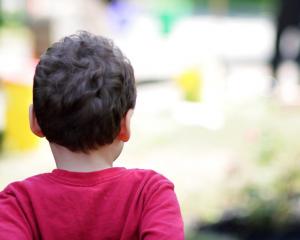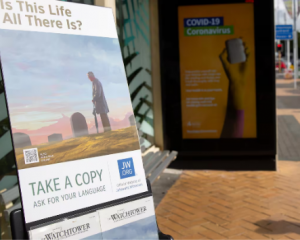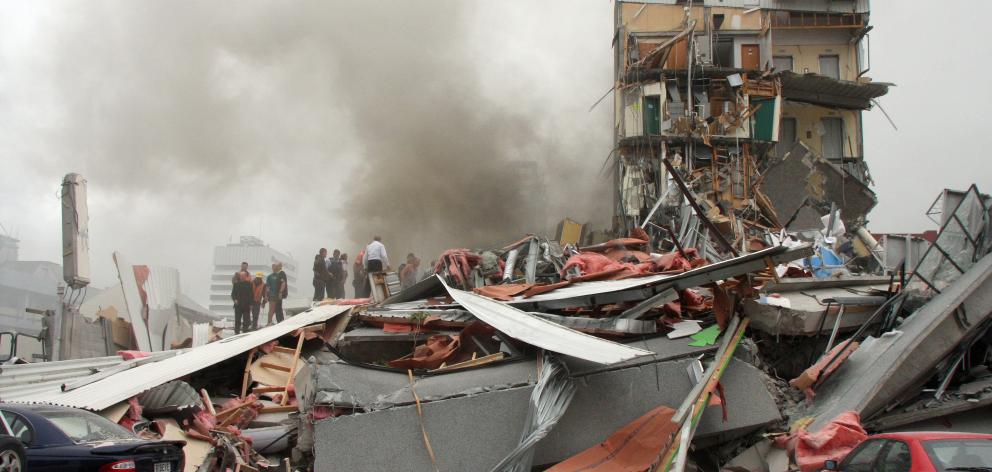
Veteran science journalist Paul Gorman, now assistant editor at the Otago Daily Times, has recounted his experiences reporting on the Canterbury earthquakes in a new book.
Portacom City: Reporting on the Christchurch and Kaikoura Earthquakes details Gorman's time at the Press newspaper, from before the first 7.1 quake hit in 2010, to the February 22 disaster that killed 185 people, and through the thousands of other aftershocks that kept coming.
Gorman, who might have been crushed had it not been for a twist of fate, tells Herald science reporter Jamie Morton about the difficulties in getting good information fast - and walking that line, often impossibly, between science communicator and scaremonger.
What compelled you to write this book?
There were quite a few reasons.
It was such an incredible time - so much happening, so much upheaval - that the idea of writing some kind of book about it all was at the back of my mind throughout 2011 and in 2012.
As a reporter you collect lots of interesting bits and pieces of information, but there's not always a place where they can be published.
So I had plenty of bits of trivia going through my head that I wanted to get down somehow, somewhere.
I also wanted to try to bring together the strands of the quake science too and at the same time cover the difficulties I had getting that information from some scientists.
For some reason I also felt compelled to get this amazing time in the Press' life down in history and pay homage to lots of my Press colleagues who went through so much and were great to work with.

There was a really interesting behind-the-scenes story developing of being at the Press at the time and how we were trying to do our jobs as normally as possible amid chaos and disaster.
University of Auckland physicist Shaun Hendy had asked me to provide case study material - on the problems I had had getting quake science info - for him to use in his BWB [Bridget Williams Books] Silencing Science.
Afterwards, he said he couldn't use everything I'd given him and suggested I write my own book.
So it all kind of came together from that.
You'd been reporting on science for a long time before the 2010-2011 quakes, and had written much about earthquakes and earthquakes science. When the big 7.1 event hit on September 4, did you feel any more prepared to do the job?
Yes, in terms of understanding the technical terms and the broad ideas of seismology and how quakes occur.
I also had good contacts in some of the science organisations.
Even when we were huddled in the hall during the M7.1 quake, that knowledge I'd picked up helped me reason that this was not the big Alpine Fault quake we were half expecting.
But I don't think anything can prepare you for the overwhelming nature of living through, and reporting on, such an event.
It dominated everything for 18 months or so.
Just when you thought it might be over there was another large aftershock.
And there was always the worry about your family being safe too, and the ongoing lack of sleep.
Just how overwhelming it got can be shown by the fact that if any of us at the Press were writing a story which was somehow not related in any way to the earthquakes, it was almost cause for celebration.
Nearly every piece on just about every subject came back to the disaster in some way or another.
For that reason weather stories were great.
What are your recollections of that period over the lead-up to the February 22 earthquake? Was there a sense among your colleagues and Cantabrians that the big one had been and gone, or was there a feeling something bigger was coming?
It was a very uneasy time.
The Boxing Day, M4.9 quake, had made everyone even more nervous.
The Press building was significantly damaged in places - you could see how window frames and decorative plaster columns outside along the Worcester St frontage did not meet up any more - and it was quite a surprise that we moved back in there in January 2011.
There was plaster falling in many places, especially after each sizeable aftershock.
But there was probably a bit of a bravado feeling that we'd be okay.
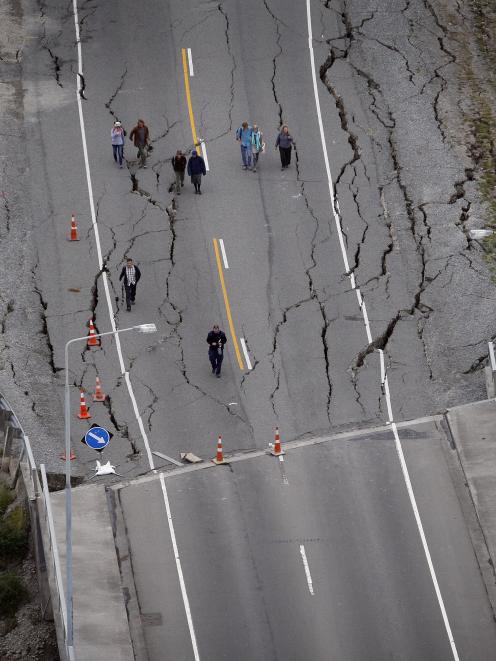
I remember it was still very much on my mind that "the" big aftershock had not yet occurred.
I'm not too sure what my workmates were thinking, but I do recall saying several times I didn't think the quakes were over.
So I was kind of waiting for it, but thought it would probably come from the Greendale Fault further away from the city.
Even though there had been a nasty aftershock from a fault under the Port Hills several days after the September 4 quake, which worried me, it was only a fleeting thought that it might be the source of something worse - and ultimately, deadly.
But that fault had alerted us and the scientists to its presence.
It was a clue if anyone was looking for one.
I wonder if more investigation could have been done into it?
Trouble is, what can you do?
You could say we should have paid more attention to what that aftershock may have been preceding, but you don't know what it could cause.
And even if you did, you don't know when that might happen.
And you can't stop it.
You were overseas when the Christchurch Earthquake did strike. As a journalist, but more so as a father and a husband, how difficult was that?
Horrible.
Absolutely one of the worst experiences of my life.
A sense of complete powerlessness at being so far away and unable to get home quickly.
And horror at sleeping for several hours while this was unfolding.
Being able to watch it on BBC News while my family, friends and workmates were in the thick of it - even thinking about it now makes me feel sick.
Fortunately I got hold of all the family within a few hours, though.
Trouble is - if I'd been there that day, I may well have been killed.
My desk was in one of the most damaged parts of the building.
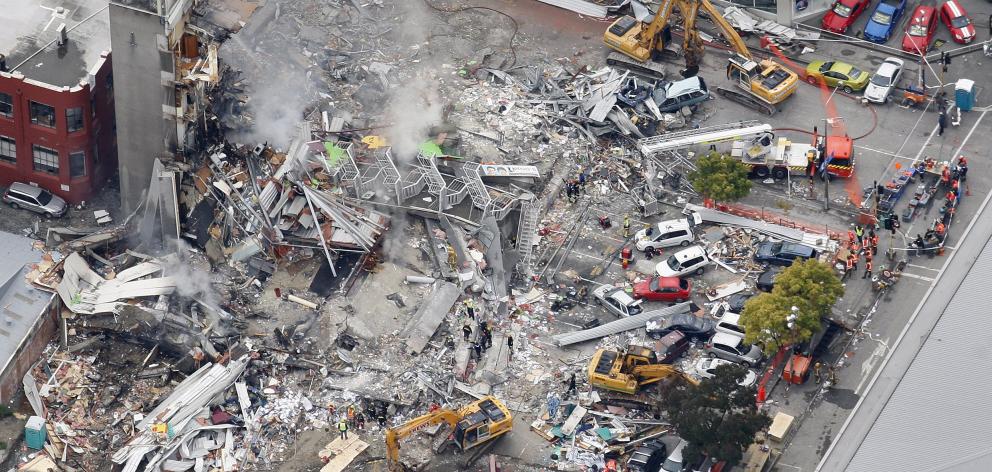
My youngest son, Bede, told his mum after the quake he wished I was home.
She said she was pleased I wasn't, when she saw the wrecked Press building.
Bizarrely, I struggled with survivor guilt on my return - guilty that I had missed it.
Also, it was the only significant quake I missed, and from a scientific point of view I felt mildly and strangely disappointed I had missed it, and that my collection of quake experiences was incomplete.
I know that sounds crazy, but I can't explain it really any better than that.
You write a lot in your book about the camaraderie shared among your colleagues at the Press. What memories do you have of those hardest days in the newsroom, and how did that togetherness help get you all through?
The Portacoms were no fun really at all.
You could barely move your arms or push back in your chair without hitting someone behind you.
The windows streamed with condensation.
It was incredible noisy, just about impossible to think or write or talk on the phone.
The place smelled of many awful things - I must apologise once again to my colleague and Portacom neighbour Charlie Gates for my egg sandwiches one Sunday.
But we all knew it was not forever, although some days it certainly felt like it.
The bosses then were amazing.

We got savvy - everyone got either a laptop or an iPhone, or both, so they could report from wherever they were.
Some people worked from home when it became too much, and were encouraged to do so.
I remember our wonderful editor Andrew Holden going round the Portacom newsroom, taking time to talk to everyone, hand on their shoulder, "how you doing, mate?", making sure they took a day off if they needed it, telling us, after a large aftershock, to check on family first before hitting the phones for work.
And if we needed to leave and go home to the family, to just go.
Of course, generally we didn't, once we knew things were okay at home.
Glenn Conway as chief reporter was great too.
The bosses organised lunchtime quizzes, barbecues, barn dances, competitions to decorate your Portacom.
It really was an amazing lesson in how to look after your staff in adversity.
Morale was sky high.
In my 14 years at the Press it was the peak.
When I left the Press in December 2016, you would never have believed you were working for the same organisation as during the quakes.
And as so many of those there at the time had left by then, I guess it wasn't.
Was there something of a them-and-us mentality among your colleagues about out-of-town journalists coming in to report on your patch? And how strong was that feeling towards other outsiders who hadn't had to live through the experience?
I guess there was.
We got used to them being there, and it did help us out, but personally I found it irritating, especially in the immediate week or so after the February quake, when we had very little space in which to work and they were taking up our seats and computers.
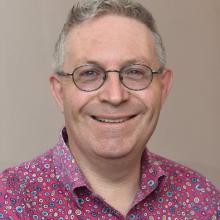
Ironically, that sense of being invaded may be how some members of the public view reporters.
It wasn't only reporters sent in though.
Lots of editorial management from Wellington and Auckland also came down for a stint in the war zone.
Some were great, others basically just got in the way.
I shared one story in the book.
In another, one manager from Wellington came up to me and business reporter colleague Alan Wood in the temporary newsroom at Logistics Dr and told us to keep the noise down because we were chatting too loudly and disturbing a room full of people - most of whom we didn't know - from out of town.
After everything we had been through, I nearly gave that manager a mouthful.
So yeah, maybe a lot of how we felt towards the outsiders came down to how sensitively they behaved to those affected the most.
Let's talk about science communication. In those first few months, how hard or difficult was it to get fast and accurate information from scientists on what was happening?
I guess the fact I knew a bit about earthquakes and geology meant I was asking scientists questions that perhaps not many other reporters at other media outlets were.
The quick quake information - where, how big, depth - was no problem generally.
It was when I tried to piece things together and provide a bit of context - like lots of aftershocks in a certain area, does that mean there is another fault we don't know about lighting up here, and what might that mean for Christchurch people?
I can understand scientists are generally cautious and don't like to go off with any half-thought through theories.
But it was often the GNS Science experts who I could not draw out on these kinds of things.
However, Dr Mark Quigley at Canterbury University and visiting US seismologist Professor Kevin Furlong were happy to help fill in the gaps.
And that, as I say in the book, upped the ante in terms of upsetting some at GNS Science.
What do you feel were the reasons behind that?
The scientists at GNS Science are employed by the government.
Those involved with the Natural Hazards Platform were also advising ministers on important quake matters.
They were in a difficult position and there were issues with red-zoning, insurance, and others, that were hugely significant.
I understand they would not want to be even slightly perceived as talking about things that might be seen as scaremongering.
But to suggest, as one of the GNS Science people did in an email I found out about later, that I was only after "cheap headlines" and sensationalist stories, and it was best not to talk to me, was insulting.
I think most people know me better than that.
It was ironic too, given some were getting upset because I was trying to do a good job and write detailed and thorough science stories - not at all once-over lightly sensational pieces or articles based on media releases.
For you, how tough was it to find that line between giving your readers the best information scientists could provide, while also trying to not to concern them any more than you needed to? In some cases, was it impossible not to be seen as the scare-mongering journalist?
We had very good debates in the newsroom about where to draw the line.
We agreed not to do anything on the "moon man" Ken Ring's predictions of another massive Christchurch quake in March 2011, which were freaking Christchurch people out.
We had to cover it though once it began affecting people's behaviour - like people leaving town, flights being booked out, or queues at petrol stations.
Actually, whatever I wrote on the quakes and the faults below the city and region, some would accuse me of scaremongering while others would defend it and say they wanted to know these things.
You can never win really.
I do recall editor Andrew Holden saying at one discussion that, if we knew something significant about, say, aftershock probabilities, and decided not to publish that for fear of worrying people, how would we defend that if the event happened and people discovered we had effectively censored the information?
You remark in the book that you can't shake the feeling that, if the experience were to be repeated again tomorrow, and even at a time when GeoNet tweets real-time information about quakes, that the lines of communication between scientists and journalists wouldn't be any more open. Why?
Perhaps this sensitivity reflects how I have been affected by the quakes and by my quake-reporting experiences, such as ongoing hassles with having questions answered, or theories or facts confirmed, and having to stomach online comments accusing you of being a scaremonger that should be sacked.
As a journalist you are very aware that there are now more former reporters working in the communications teams of government departments, science organisations and universities than there are reporters working in newsrooms.
You know that these places increasingly have policies where reporters are discouraged from contacting the source directly but should instead lodge questions with the communications team - not that we have to follow those policies.
You also know that while scientists, and academics, at universities are allowed to speak freely as the critics and conscience of society, their counterparts in Crown research institutes are not.
This is where my pessimism comes from - there are probably too many scientists afraid of speaking freely because they may upset someone in the government or a commercial client.
And there are too many who might want to control messages to make sure the bosses are not displeased.
Portacom City: Reporting on the Christchurch and Kaikoura Earthquakes, Bridget Williams Books, RRP $14.99 print, $4.99 ebook.

